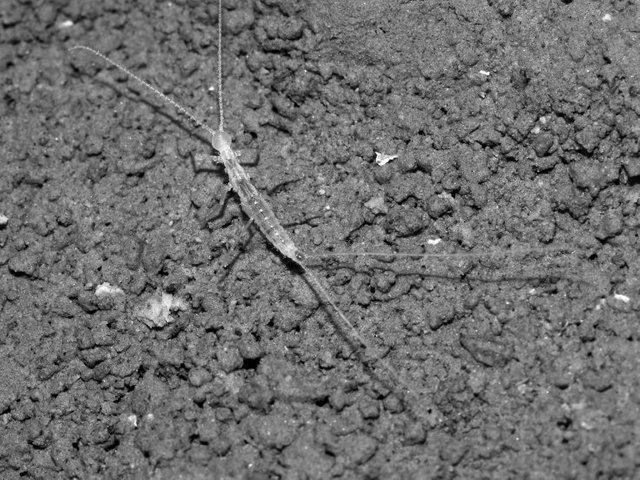New Cave Dwelling Animal Discovered With The Help Of Smelly Cheese
Yesterday, researchers from the University of Alcalá, Spain announced the discovery of a new cave-dwelling species found in the Kaptarhana cave in Eastern Turkmenistan. I am sure @mobbs will be excited to hear these news, if he already hasn't! He loves cave dwelling creatures!
Scientifically described as Turkmenocampa mirabilis, the small animal also represents an entirely new genus. In case you wonder, it looks something like this:

T. mirabilis is a new species of two-pronged bristletail (Photo by Alberto Sendra )
The Discovery
As mentioned before, T. mirabilis was found in the Kaptarhana cave, a remote cave at the foot of the mountain Koytendag which is home to more than 300 caves, sinkholes and potholes. This probably doesn't say much to you, so here's a map:
 Map of Turkmenistan with location of the cave Kaptarhana (credit)
Map of Turkmenistan with location of the cave Kaptarhana (credit)
Responsible for the discovery were Dr. Alberto Sendra from the University of Alcalá, Spain, Prof. Boris Sket, from the University of Ljubljana, and Prof. Pavel Stoev from the National Museum of Natural History, Bulgaria. Interestingly, Stoev and Sket were the first speleobiologists to visit and explore this cave after 43 years!
The new species was found with the help of pitfall traps with ethylene glycol and smelly cheese as bait, that were set along the main gallery of the cave, mostly in humid places. Although the researchers had spent about 8 hours in the cave prior to setting the traps, there was no actual sighting of the creature. This was just a lucky find!
The creature is about 1 cm long, from head to tail, pale, eyeless, and all its characteristics suggest that it is a strictly cave dwelling insect that never sees the light of day. This is not proven yet, but it is very likely. [2]
The genus name "Turkmenocampa" is a direct reference to the country where it was discovered, while the specific name mirabilis is the latin world for "remarkable".
But why did the researchers choose the latin world for "remarkable"? Well here's what Alberto Sendra, leading author of the study had to say:
"What we have here is not only a new remarkable organism, but also an amazing and unusual cave critter that has undergone a long evolutionary journey to adapt to the underground environment of Central Asia. " [1]
But to be fair, the above "evolutionary journey" is true for all troglobites.
The Importance Of The Discovery
There is a number of reasons why this discovery is very important.
First, this is the fist animal discovered in the country that is believed to be strictly cave dwelling (Troglobite). And second, the cave it was discovered is just a tiny part of the subterranean habitat of Koytendag Mountain. The research team believes that this can be the start to finding many more unindentified species:
"While many speleobiologists consider the terrestrial cave fauna in Central Asia as poor, it is places such as Kaptarhana that can turn the tables by giving us new insights about the biodiversity richness, evolutionary history, formation and functioning of the underground ecosystems of this part of the world." said Pavel Stoev. [1]

Entrance of the cave Kaptarhana (Credit)
Abstract
The news species appears in the open access journal Subterranean Biology. Here's the abstract of the study:
A striking new genus and species of Campodeidae (Diplura), Turkmenocampa mirabilis Sendra & Stoev, gen.n., sp.n., found in Kaptarhana cave in Eastern Turkmenistan is described. This represents the first record of Diplura from Central Asia and also the first terrestrial troglobiont found in Turkmenistan. The new taxon shows several unique characters such as the lack of crests on the telotarsus, the presence of a side-shoot process and the shape of barbs on the ventral side of the laminar telotarsal processes hitherto unknown in other members of this family. Although T. mirabilis is tentatively placed in the subfamily Plusiocampinae, its true affinities remain uncertain. The new finding provides further support to the importance of Kaptarhana as a refuge for a number of endemic invertebrates. [2]
References
- https://www.sciencedaily.com/releases/2017/09/170921090259.htm
- https://subtbiol.pensoft.net/articles.php?id=14631

My dear readers, thank you for reading today's article. Hopefully, you found it interesting enough to follow me, @trumpman. You may also want to check my strange animal series where you get to discover some of the world's weirdest animals! Here are the last 3 weirdos of the series:
- This Alien-like Worm Will Freak You Out!
- Meet the Platypus a Very Strange Mammal That Lays Eggs!
- Notaden bennettii: The Super Cute Holy Cross Frog
Steemstem & SteemitEducation
Steemstem is the go-to place for science on Steemit. Check it out at @steemstem or visit the #steemSTEM channel. A big thank you also goes to the guys from @steemiteducation for sharing my content all the time, so thanks :D
Greek Community
A final big thanks goes to all my fellow greeks who support me with their love! You guys rock!
Hi @trumpman! This is exactly what we are here for. We are looking for interesting content that will help teachers and students. Please read our latest post and make sure to follow the new criteria. Together we can change steemit into a virtual school!
thanks again :D
This post recieved an upvote from minnowpond. If you would like to recieve upvotes from minnowpond on all your posts, simply FOLLOW @minnowpond
wao great
Awesome finding @trumpman! got to say it has the cool looks though
thanks man :D
This post recieved an upvote from minnowpond. If you would like to recieve upvotes from minnowpond on all your posts, simply FOLLOW @minnowpond
Speleobiologists lolwut? Definitely not a real thing, I bet they just made it up for this discovery or something
This post has received a 3.02 % upvote from @buildawhale thanks to: @trumpman.
Great post about this new discovery. I guess it's not easy being cheesy.